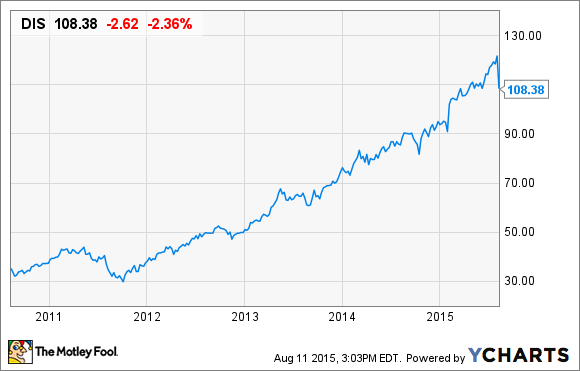Walt Disney Co (DIS 2.64%) has been one of the best blue-chip bets since the recession. The age-old media and entertainment company has found new life thanks to its growing theme park attendance, its cable TV empire, and hit movies like Frozen and its Marvel franchises.
The chart below shows Disney's seemingly effortless climb during the last five years.
But the stock hit a wall last week when the company reported second-quarter earnings. Disney shares fell 10% after the report came out, giving it its biggest single-day loss in four years, and have continued to slide since then. What gives?
In short, there are two primary drivers of the stock's recent downfall: valuation and a changing competitive landscape. Let's take a look at each one of these individually.
A pretty penny
Like admission to Disney World, which crossed the $100 mark this year, the price for the stock has gotten harder to stomach over the last few years. Though much of the stock's recent rise owes to growing profits, price inflation has also played a role as Disney's P/E ratio, the key valuation figure, had jumped all the way up to 26 prior to its earnings report.
As you can see from the chart above, which does not include Disney's report last week, earnings-per-share growth has been strong, more than doubling over the last five years, but stock price appreciated at nearly twice the pace. Its P/E ratio has risen 50% in that time, and that kind of divergence is generally not sustainable over the long-term. The broad-market S&P 500 has experienced a similarly inflated valuation over that time period, increasing by about a third to 21. However, that makes stocks like Disney especially vulnerable to an investor letdown, which is exactly what happened last week.
Not so magic kingdom
Though Disney may be best known for its theme parks and animated movies, the primary driver of the company's profit in recent years has been its media networks division, led by ESPN, which delivers more than half of the company's operating income. Profit in that division has risen just 2% through the first nine months of the year, and within its predominant cable segment has actually fallen 1%. Notably, advertising revenues and subscribers at ESPN are falling, as the report makes clear, and CEO Bob Iger said on the earnings call that ESPN had experienced "some subscriber losses" in the quarter, which seemed to have prompted the sell-off.
CFO Christine McCarthy also lowered the company's long-term operating profit guidance from high-single-digits to mid-single-digits, a sign of the impact that ESPN's subscriber losses are having.
Media stocks across the board tumbled last week as content providers and cable companies noted subscription declines. While they are too small now to lead to actual profit declines, cord-cutting is likely to only speed up as technology improves and streaming competitors double down on original content.
For Disney, that means that its strongest business is quickly turning into a vulnerability. From fiscal 2010 to fiscal 2014, which ended last September, Disney's operating profits from media networks grew from $5.1 billion to $7.3 billion, an increase of 43%. Cable profits were up 45% in that time period to $6.5 billion.
Its other businesses performed even better, with operating income growing from $2.4 billion to $5.7 billion in that period, though it owes much of that growth to the resurgence of Disney's studio entertainment category as the company capitalized off its 2009 purchase of Marvel Entertainment and increasing revenue at its theme parks.
While Disney's other businesses are still strong, those growth rates are also likely to slow as the effects of the economic recovery wear off. But the #1 concern for Disney investors has to be the troubles at its cable properties. If profit growth from that division turns negative, Disney stock could retreat even more.








